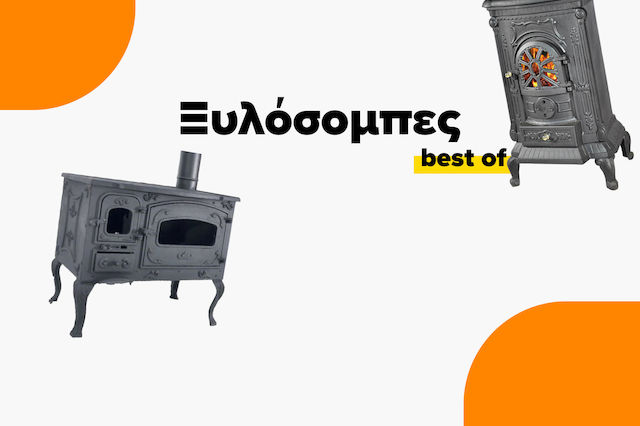Pellet stove without a chimney or wood stove without electricity? What should you choose?
The increasing prices of electricity, heating oil, and natural gas have prompted consumers to reconsider their home heating methods. As a result, traditional methods such as heating with a stove are experiencing a resurgence. However, the advancement of technology has introduced new considerations in this product category, which we must take into account before making any purchase.

¹ There are Pellet stoves that have a battery so that their operation is not interrupted during a possible power outage.
² It should be noted that there are pellet stove models that also support remote control through the use of a mobile phone.
Available Types of Stoves
Air Heaters
The term air heater that accompanies several of the available stove models refers to the transfer of warm air to various adjacent spaces with the help of fans. Essentially, thanks to the fan, it provides faster distribution of warm air in the area.
They are the stoves with the most classic functionality, as they emit heat only to their installation space through radiation and through airflow. Both types of stoves can be air heaters, whether they are wood stoves or pellet stoves.
Tip: In case the stove has a fan, it is recommended to investigate the noise generated during its operation. The unit of measurement for noise is the decibel (dB). Since it is difficult to perceive how quiet or noisy the fan will be during its operation just by reading this specific value, it is suggested to use it comparatively. That is, to compare the db value produced by the stove we are interested in, with that produced by a device for which we have a personal opinion about its performance.
Radiators
The term radiators refers to stoves that also have the capability to heat water. They have dual functionality, as they warm the space while simultaneously being able to connect to the radiator network, transferring part of the generated heat to the water flowing through the units.
This means that with the help of the installed piping and a circulator, the stove can be connected to the existing radiator heating bodies, warming the entire house. This applies to both wood stoves and pellet stoves.
Air Ducts
Pellet stoves with air ducts allow the stove to distribute heat through the air in the installation area (not just through radiation) without the use of fans. It can transfer warmth throughout the entire house by connecting to the existing ductwork in the building and provide uniform temperature.
They are named after the extraction of hot air through suitable ducts. These ducts can be integrated into the stove itself or in adjacent rooms where they deliver heat to the space.
Kitchen
Kitchen stoves, as their name suggests, have dual functionality as they heat the space while also being able to be used as regular stoves. That's why they are mainly installed in the kitchen area.
Wood-burning stove
This particular type belongs to the category of wood-burning stoves and essentially features a front surface with a large glass, giving the feeling of a fireplace.
It should be noted that each stove can belong to more than one category. For example, there are stoves that have functionality like the one described in the "Kitchen" category, while at the same time they can provide thermal energy to the radiator water like the stoves in the "Radiator" category.
Power Selection (kW)
In order for the stove to meet the heating needs of the space in the most efficient way, we must carefully choose its power. The term power refers to the thermal energy that the stove can deliver to the space per unit of time. Power is measured in kW. Calculating the power that the stove should have is a complex process that requires scientific analysis, as we must take into account a multitude of parameters.
Below are some of the most important:
- The volume of the space we want to heat
- The building materials (presence of insulation/aluminum frames)
- The floor on which the space in question is located (penthouse or intermediate floor)
- The orientation of the space
Because the scientific processing of the aforementioned data is quite complex, a empirical rule is provided below to help us estimate, by approximation, the kW that the stove we will purchase should support.
Empirical Rule: 5 kW per 10 m²
The purpose of the above empirical rule is to avoid purchasing a stove that is excessively small or large (in terms of kW).
Tip: If the stove is particularly large, the space will be excessively heated, resulting in either having to open a window or door, or reducing the fuel quantity in the stove.
In the first case, additional fuel will be consumed without benefit.
In the second case, the stove will not have the expected performance, the flame will be weakened, more smoke will be produced than during normal operation, and the humidity in the chamber will be increased, causing the stove glass to fog up faster.
Tip: If the stove is particularly small, in order to heat the space adequately, it will be necessary for the stove to operate with fuel overfeeding, which can overheat and damage both the stove and the flue gas system.
Performance
The appropriate power of the stove should be examined in combination with its performance, as on the one hand the stove should release the desired thermal energy into the space, and on the other hand this should be combined with high efficiency. By efficiency, we refer to the ratio of the energy delivered to the space to the energy contained in the fuel used by the stove.
Tip: Among two stoves of the same power that deliver the same thermal energy to the space at the time of comparison, the stove with higher efficiency consumes less fuel and therefore is more economical.
Construction Material
When searching for our future stove, we may wonder about its construction material. The majority of both types of stoves are made of either cast iron (mante) or steel. The difference is that while pellet stoves are mostly made of cast iron or steel, wood stoves also have the additional option of ceramic and stone.
Cast iron as a material takes more time to heat up but maintains its temperature for a longer period of time. The same property applies to ceramic and stone coatings that some wood stoves have. On the other hand, steel heats up in a shorter period of time but also cools down faster.
Tip: The above differences between the two materials should not concern us to a great extent because modern stoves, due to advanced technology, do not differ significantly in terms of their performance depending on their construction material.

Certifications
Stoves can have various certifications. Below are some of the most common:
CE/ EN 14785 Certification
Stoves with the CE/ EN 14785 marking comply with the European Union standard 14785. This standard relates to specifications concerning the design, construction, safety, performance, and control of stoves that are powered by a Pellet mechanism and have a power output of up to 50kW. These stoves may have an internal or external hopper for pellet storage and always operate with the door closed.
CE/ EN 13240 Certification
Stoves with the CE/ EN 13240 marking comply with the European Union standard 13240. This standard relates to specifications concerning the design, construction, safety, performance, and control of heating devices that are manually fed with solid fuels. This specific standard does not cover devices equipped with fans to assist combustion.
EPA Certification
The EPA certification is issued by the Environmental Protection Agency of the United States and pertains to the allowable emission limits that wood stoves must meet. Therefore, wood stoves that are EPA certified are proven to be a more environmentally friendly option. It should be emphasized that Pellet stoves do not receive such certification because, by their nature (as previously mentioned), they exhibit much more environmentally friendly behavior.
Additional Features & Characteristics
Thermostat
The presence of a thermostat keeps the temperature stable in the room while also saving fuel.
Automatic Glass Cleaning Mechanism
This mechanism helps the glass stay clean for a longer period, allowing for continuous viewing of the flame during burning.
Ash Collection Container
A large ash collection container that can be easily removed and repositioned facilitates the regular maintenance of the stove.
Catalyst
Some stove models are equipped with a catalyst to achieve cleaner combustion, meaning combustion combined with lower pollutant emissions. It should be noted that, like all catalysts, stove catalysts are subject to wear and require replacement according to the manufacturer's specifications.
Want more suggestions for heating without electricity? Read our article on the best gas heaters!
Sources: epa.gov en-standard.eu en-standard.eu





Be the first to leave a comment!